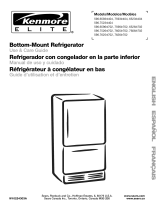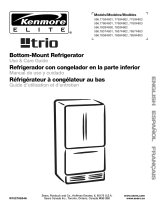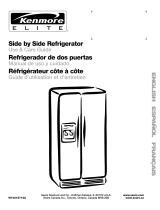
2
TABLE OF CONTENTS
PROTECTION AGREEMENTS........................................................ 2
WARRANTY.................................................................................. 3
REFRIGERATOR SAFETY .............................................................. 4
Proper Disposal of Your Old Refrigerator......................................... 4
INSTALLATION INSTRUCTIONS ...................................................5
Unpack the Refrigerator ....................................................................... 5
Location Requirements........................................................................... 5
Electrical Requirements ......................................................................... 6
Water Supply Requirements ................................................................ 6
Connect the Water Supply...................................................................7
Refrigerator Doors and Drawer........................................................... 8
Adjust the Doors......................................................................................11
Water System Preparation...................................................................11
REFRIGERATOR USE ................................................................... 12
Opening and Closing Doors................................................................12
Using the Controls .................................................................................12
Ice Maker and Ice Storage Bin...........................................................13
Water and Ice Dispenser.....................................................................14
Water Filtration System.......................................................................15
REFRIGERATOR FEATURES .........................................................16
Refrigerator Shelves..............................................................................16
Crisper and Crisper Cover ...................................................................16
Crisper Humidity Control..................................................................... 16
Gourmet Pantry™ Drawer.................................................................. 17
Wine Trivet / Can Rack ...................................................................... 17
DOOR FEATURES.........................................................................17
Built-In Door Organizer ....................................................................... 17
Door Bins................................................................................................. 17
Dairy Center...........................................................................................17
Fresh-N-Ready Bin™............................................................................ 18
REFRIGERATOR CARE.................................................................18
Cleaning.................................................................................................. 18
Changing the Light Bulb ...................................................................... 19
Power Interruptions............................................................................... 19
Vacation and Moving Care................................................................ 19
TROUBLESHOOTING..................................................................20
Refrigerator Operation........................................................................20
Temperature and Moisture...................................................................21
Ice and Water........................................................................................21
ACCESSORIES............................................................................. 23
WATER FILTER CERTIFICATIONS ............................................... 23
PERFORMANCE DATA SHEETS...................................................24
SERVICE NUMBERS ..................................................BACK COVER
ÍNDICE........................................................................................ 26
TABLE DES MATIÈRES................................................................. 50
PROTECTION AGREEMENTS
Master Protection Agreements
Congratulations on making a smart purchase.
Your new Kenmore
®
product is designed and manufactured for years of dependable
operation. But like all products, it may require preventive
maintenance or repair from time to time. That’s when having a
Master Protection Agreement can save you money and
aggravation.
The Master Protection Agreement also helps extend the life of your
new product. Here’s what the Agreement* includes:
✔ Parts and labor needed to help keep products operating
properly under normal use, not just defects. Our coverage goes
well beyond the product warranty. No deductibles, no
functional failure excluded from coverage— real protection.
✔ Expert service by a force of more than 10,000 authorized Sears
service technicians, which means someone you can trust will be
working on your product.
✔ Unlimited service calls and nationwide service, as often as you
want us, whenever you want us.
✔ “No-lemon” guarantee – replacement of your covered product
if four or more product failures occur within twelve months.
✔ Product replacement if your covered product can’t be fixed.
✔ Annual Preventive Maintenance Check at your request – no
extra charge.
✔ Fast help by phone – we call it Rapid Resolution – phone
support from a Sears representative on all products. Think of us
as a “talking owner’s manual.”
✔ Power surge protection against electrical damage due to power
fluctuations.
✔ $250 Food Loss Protection annually for any food spoilage that
is the result of mechanical failure of any covered refrigerator or
freezer.
✔ Rental reimbursement if repair of your covered product takes
longer than promised.
✔ 10% discount off the regular price of any non-covered repair
service and related installed parts.
Once you purchase the Agreement, a simple phone call is all that it
takes for you to schedule service. You can call anytime day or
night, or schedule a service appointment online.
The Master Protection Agreement is a risk free purchase. If you
cancel for any reason during the product warranty period, we will
provide a full refund. Or, a prorated refund anytime after the
product warranty period expires. Purchase your Master Protection
Agreement today!
























